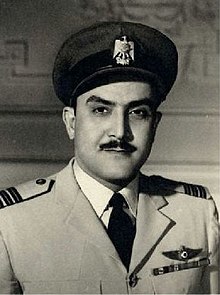Hassan Ibrahim
Hassan Ibrahim | |
|---|---|
 Portrait of Wing Commander Hassan Ibrahim (1952) | |
| Born | 1917 |
| Died | 1990 (aged 72–73) |
| Nationality | Egyptian |
| Alma mater | Egyptian Air Academy |
| Occupation | Military officer |
| Years active | 1940–1980s |
Hassan Ibrahim (1917 – 1990) was an Egyptian Air Force officer and one of the founders of the Free Officers movement.
Early life and education[]
Ibrahim was born in 1917.[1] He was a graduate of the Egyptian Air Academy.[2]
Career[]
In 1952, Ibrahim served as an Air Force group captain.[1] He was one of the three judges, who tried the members of the Brotherhood after their attempted assassination attack against then president Gamal Abdel Nasser in 1954.[3] The other three judges were Anwar Sadat and Abdel Latif Boghdadi.[3] The same year he was among the officers who arrested Mohammed Naguib. Ibrahim was also appointed minister for presidential affairs in 1954.[2] Two years later, in 1956, Ibrahim became the head of the Egyptian economy agency.[2] After dealing with business for a while, in February 1964, he was appointed as one of seven vice presidents of Nasser.[2] Ibrahim resigned from office in 1966 due to Nasser's request to end his relationship with a woman, and continued business activities.[2]
Free Officers Movement[]
Ibrahim was among five military officers who formed the first cell of the Free Officers movement in July or September 1949.[4][5] Although it is argued that Ibrahim along with other officers was a member of the Muslim Brotherhood's special unit from 1944 to 1945,[4][5] there is another report stating that Ibrahim was part of the group called Young Egypt.[2] In addition, Ibrahim was one of the nine-member leadership group of the Free Officers movement.[1] The movement led the 1952 Revolution.[6] Then Ibrahim became a member of the 14-member Revolution Command Council (RCC) that was charged with the running of Egypt following the success of the revolution.[1]
Death[]
Ibrahim died in 1990.[1]
Honour[]
Foreign honour[]
- Honorary Grand Commander of the Order of the Defender of the Realm (Malaysia; 1965)[7]
References[]
- ^ a b c d e "All the revolution's men". Al Ahram Weekly. 595. 18–25 July 2002. Archived from the original on 30 April 2012.
- ^ a b c d e f Robin Bidwell (12 October 2012). Dictionary of Modern Arab History. Routledge. p. 150. ISBN 978-1-136-16298-5.
- ^ a b Steven A. Cook (1 September 2011). The Struggle for Egypt: From Nasser to Tahrir Square. Oxford University Press. p. 59. ISBN 978-0-19-979532-1.
- ^ a b Mohammed Zahid (15 April 2012). The Muslim Brotherhood and Egypt's Succession Crisis: The Politics of Liberalisation and Reform in the Middle East. I.B.Tauris. p. 76. ISBN 978-1-78076-217-3.
- ^ a b Hazem Kandil (13 November 2012). Soldiers, Spies and Statesmen: Egypt's Road to Revolt. Verso Books. p. 37. ISBN 978-1-84467-961-4.
- ^ "The Revolution and the Early Years of the New Government: 1952-56". Country Studies. Retrieved 31 January 2013.
- ^ "Senarai Penuh Penerima Darjah Kebesaran, Bintang dan Pingat Persekutuan Tahun 1965" (PDF).
External links[]
 Media related to Hassan Ibrahim at Wikimedia Commons
Media related to Hassan Ibrahim at Wikimedia Commons
- 20th-century Egyptian politicians
- 1917 births
- 1990 deaths
- Egyptian Air Academy alumni
- Egyptian Air Force air marshals
- Egyptian military leaders
- Free Officers Movement (Egypt)
- Government ministers of Egypt
- Recipients of the Order of the Defender of the Realm
- Vice-presidents of Egypt